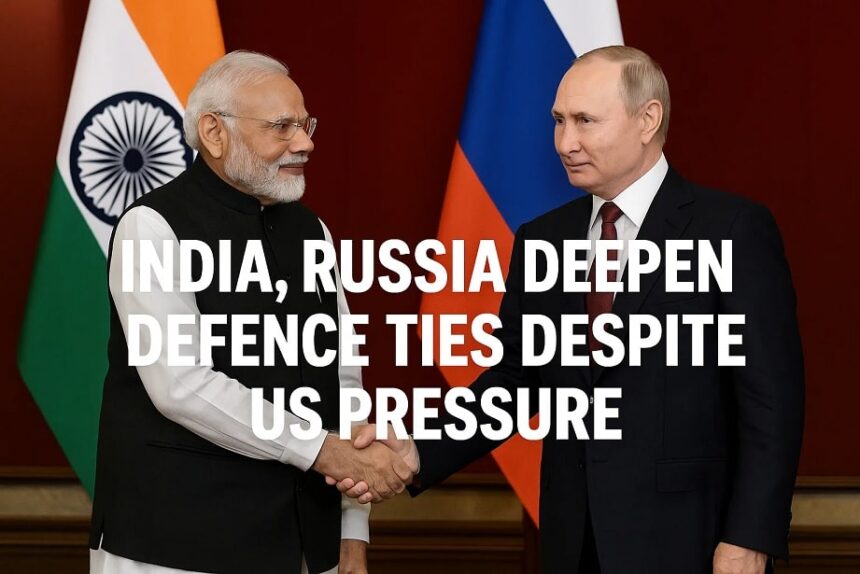On August 6, 2025, India and Russia reaffirmed their commitment to deepen their defense partnership during a high-level meeting in Moscow between Indian Ambassador Vinay Kumar and Russian Deputy Defense Minister Colonel-General Alexander Fomin. Conducted in a “warm and friendly atmosphere,” the talks underscored the resilience of the India-Russia “special and privileged strategic partnership” despite U.S. President Donald Trump’s threats of sanctions and a 25% tariff on Indian goods over India’s continued oil trade with Moscow. The discussions, part of the India-Russia Inter-Governmental Commission on Military Technical Cooperation (IRIGC-MTC), focused on expanding joint military exercises, arms deals, and co-development projects like the BrahMos missile, signaling India’s determination to maintain strategic autonomy amid geopolitical tensions.
Background of India-Russia Defense Ties
India’s defense relationship with Russia, rooted in Cold War-era Soviet support, remains a cornerstone of its military strategy. Russia has supplied 60-70% of India’s military hardware over decades, including T-90 tanks, Su-30MKI jets, INS Vikramaditya aircraft carrier, and S-400 air defense systems. Between 2013-2022, Russia accounted for 45-64% of India’s arms imports, per the Stockholm International Peace Research Institute (SIPRI), though its share dropped to 36% in 2024 as India diversified. Key joint ventures, like the BrahMos cruise missile (50.5% India, 49.5% Russia) and AK-203 rifle production under the “Make in India” initiative, highlight deep collaboration. A March 2025 deal for advanced 1,000 HP engines for T-72 tanks, with technology transfer, further strengthens ties.
The India-Russia Inter-Governmental Commission (IRIGC-MTC), established in 2000, oversees military-technical cooperation, with annual ministerial meetings and nine sub-groups. The 2021-2031 Military Technical Cooperation Agreement, signed during the inaugural India-Russia 2+2 Dialogue in Delhi, emphasizes research, production, and after-sales support. India’s reliance on Russian equipment is driven by cost-effectiveness, flexible payment terms, and familiarity, critical for its rivalries with China and Pakistan.
U.S. Pressure and Tariff Threats
U.S. President Donald Trump’s imposition of a 25% tariff on Indian goods on August 1, 2025, and threats of secondary sanctions target India’s $68.7 billion trade with Russia, particularly its 35-40% share of India’s crude oil imports since the Ukraine war began in 2022. Trump labeled India and Russia “dead economies,” criticizing India’s resale of Russian oil for profit, which he claims funds Russia’s war efforts. Indian officials, including External Affairs Minister S. Jaishankar, called the tariffs “unjustified,” noting that the U.S. and EU also trade with Russia (EU-Russia trade at €67.5 billion in 2024). India’s National Security Adviser Ajit Doval’s Moscow visit on August 5, 2025, and Jaishankar’s planned trip in mid-August underscore India’s defiance.
The U.S. has delayed CAATSA sanctions over India’s 2018 $5.43 billion S-400 purchase, but Trump’s unpredictability raises risks for future deals, like the proposed S-500 missile system with co-production and re-export clauses to bypass sanctions. Posts on X reflect Indian sentiment, with users like @TheNavroopSingh praising India’s stand against U.S. “hypocrisy” while noting EU and U.S. reliance on Russian energy.
India’s Balancing Act with the U.S.
India’s defense ties with the U.S. have grown significantly, with $20 billion in procurements since 2005, including C-17 Globemaster III, Apache helicopters, and MQ-9B drones. Agreements like LEMOA, COMCASA, and BECA, plus joint exercises like Talisman Sabre 2025, deepen interoperability, driven by shared concerns over China in the Indo-Pacific. However, the U.S. offers limited technology transfer compared to Russia, and initiatives like the Defence Technology and Trade Initiative (DTTI) have underperformed. India’s refusal to buy F-35 jets signals caution to preserve diplomatic flexibility.
India’s “Aatmanirbhar Bharat” initiative, aiming for self-reliance, has reduced Russian arms imports from 76% in 2009 to 36% in 2024, with France (Rafale jets) and Israel (missile defense) gaining ground. The exit from the Russia-led Fifth Generation Fighter Aircraft program marks a shift, but legacy systems ensure Russia’s relevance. India leverages U.S. deals, like potential Javelin missile co-production, to negotiate tariff relief while maintaining Russian ties for affordability.
Strategic and Geopolitical Implications
India’s defense ties with Russia are critical for its security, given border tensions with China and Pakistan. Russian equipment, like T-90 tanks and S-400 systems, forms the backbone of India’s military, and sanctions-induced delays in spares or components could erode readiness. Russia’s growing alignment with China, including military aid and dual-use component reliance, raises concerns for India, particularly if Moscow deepens ties with Pakistan or supplies advanced platforms to Beijing.
India’s multi-vector diplomacy, evident in its BRICS and Quad roles, allows it to balance U.S. and Russian ties. The $68.7 billion India-Russia trade, including $63.84 billion in imports, supports India’s energy security, with plans to hit $100 billion by 2030. Trump’s tariffs, contributing to the Indian rupee’s drop to 88.10 on August 5, 2025, may push India to negotiate deeper Russian oil discounts. India’s refusal to condemn Russia’s Ukraine invasion, advocating dialogue instead, reflects its pragmatic approach to preserve this partnership.
Risks and Challenges
Sanctions Risk: U.S. CAATSA sanctions could target future Russian deals, like the S-500, complicating India’s procurement.
Russian Reliability: Sanctions and Russia’s focus on Ukraine have delayed S-400 deliveries, raising concerns about supply chain disruptions.
China-Russia Axis: Russia’s growing dependence on China, including a potential Russia-China-Pakistan axis, could limit Moscow’s flexibility with India.
Economic Strain: U.S. tariffs and a $41 billion trade surplus with the U.S. create pressure, but India’s $63.84 billion imports from Russia are critical for energy affordability.
Domestic Push for Self-Reliance: India’s “Make in India” initiative may reduce reliance on Russia long-term, though legacy systems ensure continued dependence.
What’s Next
India will likely deepen defense cooperation with Russia through upcoming summits, with Jaishankar’s mid-August 2025 Moscow visit focusing on energy and arms deals. Potential S-500 missile system negotiations, including co-production and re-export rights, could counter U.S. sanctions. India may use U.S. defense purchases, like Predator drones or GE-414 engines, as leverage in tariff talks. The 22nd IRIGC-MTC meeting in 2025, hosted by Russia’s Andrey Belousov in India, will review ongoing projects like T-90 tank upgrades and Su-30MKI production. India’s role in BRICS and SCO will bolster its resistance to U.S. pressure, while domestic production under “Aatmanirbhar Bharat” aims to reduce import reliance.
Conclusion
India’s reaffirmation of defense ties with Russia on August 6, 2025, despite U.S. tariffs and sanctions threats, underscores its commitment to strategic autonomy. The partnership, built on decades of trust and cost-effective arms, remains vital for India’s security against China and Pakistan. While U.S. defense ties grow, offering advanced technology, India’s balancing act ensures Russia’s role as a key supplier. As geopolitical tensions and economic pressures mount, India’s multi-vector diplomacy, leveraging BRICS, Quad, and bilateral engagements, will shape its ability to maintain this delicate equilibrium, securing energy, defense, and strategic interests.












